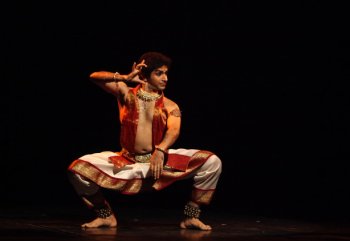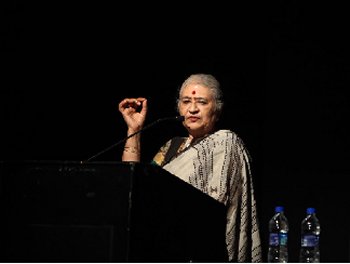
|   |

|   |
Dec 20: Purush is the imagination, Prakriti is the reality? - Kiran Rajagopalan e-mail: kiran.rajagopalan@gmail.com Photos: Vivekanandan December 20, 2013 The annual “Natya Darshan” dance conference, hosted by Kartik Fine Arts, has finally returned to Chennai amidst extensive renovations of Bharatiya Vidya Bhavan. For the last two years, Dr. Anita Ratnam and her exceptional team of scholars, performers, writers, designers, and assistants have consistently raised the standard of excellence in organizing and executing arts conferences in Chennai. More importantly, Dr. Ratnam has deliberately pushed boundaries with her innovative “conclaves” on epic, mad, and divine women of the past and present. However, her latest conclave, “Purush” co-curated by Toronto-based Hari Krishnan, is a celebration and an examination of the global male dancer. According to Dr. Ratnam, “Purush” is her “most ambitious conclave to date with nearly 100 participants from around the world.” In many ways, it is a continuation of her landmark 1995 conference and performance series which also focused exclusively on male dancers.  Pavitra Bhat In her fascinating discussion on the “shrinking space for the male dancer,” Ms. Venkataraman emphasized that conventional notions of gender are irrelevant in Indian classical dance as it is inherently transformative. Ideally, what a dancer transforms into on stage should be far more important for the audience than his or her actual gender. She also highlighted a disturbing trend in classical Indian dance – the consistent sidelining of talented male dancers. Certain dance forms once practiced exclusively by men, such as Kuchipudi and Sattriya, have become “fractured and diluted” by female dancers with less skill. It is also ironic that male Kathak dancers now struggle to find opportunities to perform solo even though their tradition has always celebrated male virtuosos.  Leela Venkataraman  Dr. Devdutt Pattanaik He then segued into an examination of the metaphoric and metaphysical implications of the dances of Nataraja and Krishna. Nataraja’s dance, which is performed in total isolation, represents a fervent, internal search for bliss. In contrast, Krishna’s dance is a performance in the truest sense as it is a communal spectacle used specifically to build rapport and to engage others in worship. The morning sessions ended with a panel discussion by Dr. Ann David and Dr. Sandra Chatterjee on “the idea of the male dancer in India.” Rather paradoxically, both speakers focused mainly on Indian male performers whose work is steeped in various Indian dance traditions but mainly presented outside of India. For example, Dr. David explored the issues of orientalism and gender through Ram Gopal’s highly successful performances in Great Britain prior to World War II and during the 1950s. British art critics were immediately captivated by Ram Gopal’s physical beauty along with the “exotic” blend of masculine vigor and feminine grace in his movements.These traits collectively added an alluring androgynous quality to his performances, and they also subtly challenged European notions of masculinity. Dr. Chatterjee tackled similar issues while discussing her ongoing research on Uday Shankar’s work in Germany during the 1930s. Shankar thrived in Germany because of the prevailing attitude that the Indian performing arts were endangered. Therefore, he was “overestimated” as an authentic practitioner of India’s vanishing sacred arts, and his performances were thought of as a continuation of a “tradition from time immemorial.” Interestingly, Shankar was also admired for his androgyny in performance, but he consciously shrouded such notions of gender with an air of “divinity and spirituality.” This was in stark contrast to Ram Gopal, whose penchant for glamor and seduction attracted many admirers. 
Prof. Hari Krishnan,Dr. Sandra Chatterjee and Dr. Ann.R.David
The first day ended right on schedule after a lively discussion between the audience and the panelists. This reporter must also mention a very important highlight of the conference. Rex’s amazing stage set designs invariably transform Bharatiya Vidya Bhavan’s auditorium for each conclave, and he works his magic once again for ‘Purush.’ His minimalist, streamlined stage décor is perhaps a subtle nod to the “masculine aesthetic.” The creative use of Nataraja as the main decorative motif, and the picture-framed projection screen are inspired touches! Kiran Rajagopalan, disciple of A. Lakshmanaswamy, is a Bharatanatyam dancer based in Chennai. |